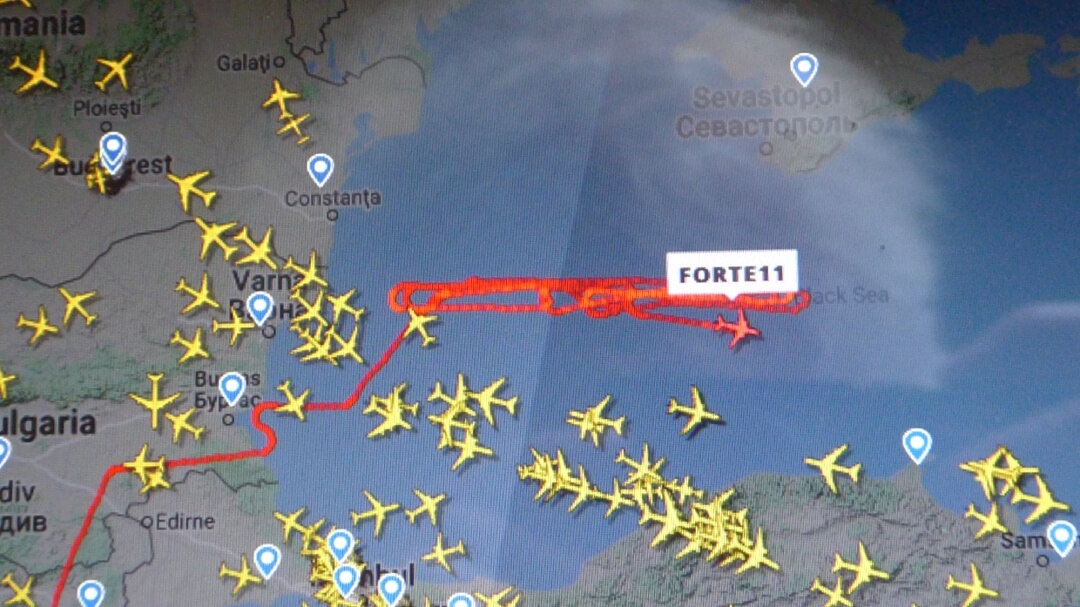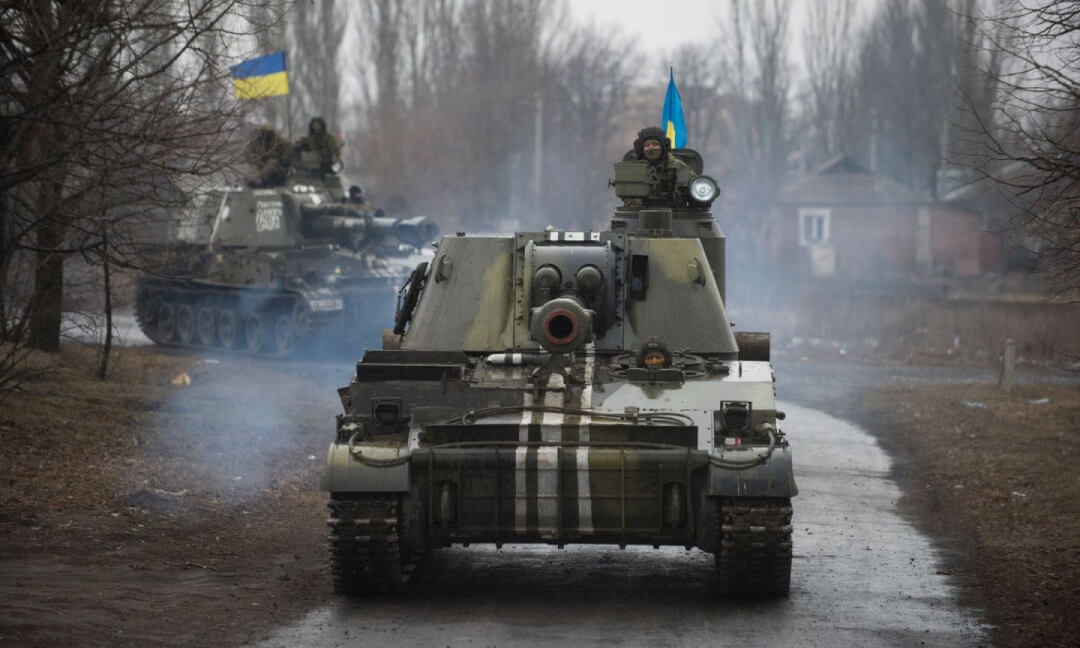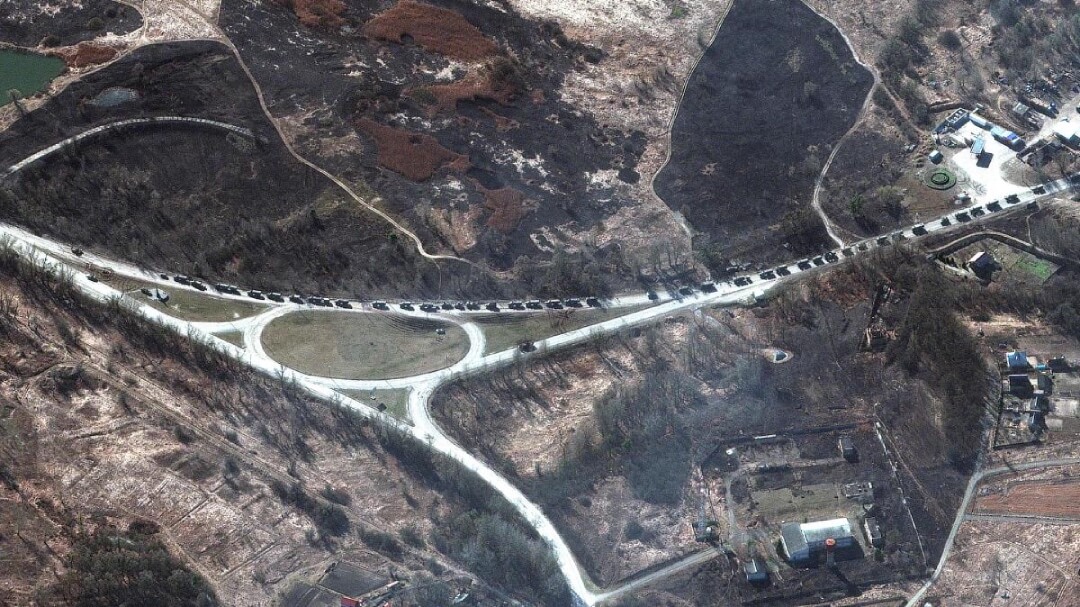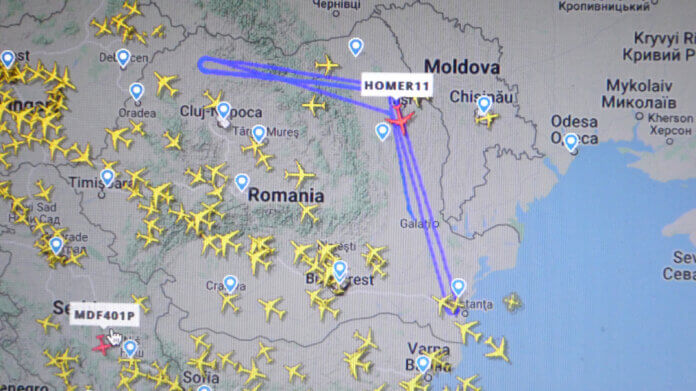An analysis of how Russia’s invasion was monitored by NATO, together with reflections on two key elements of the fight so far – the use of artillery and Russian logistical planning.
The brutal Russian invasion of Ukraine continues to headline globally, with war crimes now being discovered in many locations. At time of writing, after failing to take Ukraine’s capital Kyiv, the Russian Army has withdrawn from this area (perhaps temporarily), and looks to be moving its strategic focus to the Donbas in the east of the country to capture the Donetsk and Luhansk regions in their entirety.
Reflecting on this first phase of the invasion, contributor David Oliver has brought together some observations on how the invasion has been monitored by NATO from airborne intelligence, surveillance and reconnaissance (ISR) aircraft operated by its member states, albeit in either NATO or unrestricted airspace. It must be recognised that an unidentified amount of this intelligence was passed to the Ukrainian armed forces as they struggled to hold back the initial advance, and in preventing the ultimate capture of Kyiv.
Stephen W. Miller also reflects on the artillery deployed by both sides, and gauges its use and effectiveness. Miller also analyses what appears to be a failure of the invading forces to organise their logistical plan, which not only effected the momentum but also the effectiveness of the Russian campaign.
NATO’s Airborne ISR
During March, there was a ramping up of NATO surveillance flights along the borders of Ukraine with most activity seen taking place in Romanian airspace. This includes flights by US Navy Lockheed EP-3Es flying along the border between Romania and Moldova. The EP-3E Aries II is a land-based multi-intelligence reconnaissance aircraft based on the P-3 Orion airframe, 16 of which were recently upgraded from signals intelligence (SIGINT) to a multi-intelligence gathering capability. With sensitive receivers and high-gain dish antennas, the EP-3E exploits a wide range of electronic emissions from deep within targeted territory. The crew fuses the collected intelligence along with off-board data and disseminates the collaborated information for direct threat warning.
Royal Air Force (RAF) Boeing Airseeker and US Air Force (USAF) RC-135W Rivet Joint airborne SIGINT platforms, with a sensor suite that allows the mission crew to detect, identify and geolocate signals throughout the electromagnetic spectrum, have been flying along the Ukraine and Belarus borders.
Based at RAF Waddington, for the purposes of sensor and system upgrades, No 51 Squadron’s three Airseekers are considered an extension of the USAF Rivet Joint fleet, ensuring they remain at the cutting edge of capability.
They have been joined by USAF E-8C Northrop Grumman Joint Surveillance Target Attack Radar System (Joint STARS). Its 24 foot (7.3 metre) long, side-looking phased array antenna can be tilted to either side of the aircraft where it can develop a 120-degree field of view covering nearly 19,300 square miles (50,000 square km) and is capable of detecting targets at more than 135 nautical miles (250 kilometres). The radar also has some limited capability to detect helicopters, rotating antennas and low, slow-moving fixed wing aircraft.
Operating in Poland’s airspace is one of the Italian Air Forces’s two Gulfstream G550 Airborne Intelligence, Surveillance, Reconnaissance, Target Acquisition, Electronic Warfare (AISREW/ISTAR) acquired from Israel Aerospace Industries (IAI). Equipped with Leonardo Osprey 50 AESA surveillance radar and a Spydr suite by L3Harris, they are operated by the 14th Air Wing based at Pratica di Mare Air Base.
The US Army has deployed its Beechcraft RC-12X Guardrails to Lithuania where they conduct Intelligence, Surveillance, and Reconnaissance (ISR) missions along the border with Belarus and Kaliningrad, the exclave of Russia located on the coast of the Baltic Sea.
The US Army’s Airborne Reconnaissance Targeting & Exploitation Multi-Mission Intelligence System (ARTEMIS) aircraft is based on the Bombardier Challenger 650. The high-speed, ISR-gathering demonstrator built by Leidos in response to a US Army requirement to replace its RC-12X Guardrail aircraft. One of only two ARTEMIS aircraft has both electronic collection and ground scanning radar so it could see the movement of military vehicles in real time, and collect RF [radio frequency] signals emitted by adversaries. Its sensors can reach hundreds of miles, and based at Constanta in Romania, it can see well into Belarus, Kaliningrad, and perhaps even into the Donbas region. The route is probably the closest that the US would want to take this plane to Russia and Belarus, while keeping the plane safely in NATO airspace.
USAF and NATO Boeing E-3A Sentry Airborne Warning and Control System (AEW&C) aircraft are also in the mix of surveillance capable platforms targeting Russian forces in Ukraine. Noticeable are the lack of RAF E-3D aircraft that were withdrawn from service last August, one of which has bee sold to Chile, and the Raytheon Sentinel R.1 fleet (based on a Bombardier Global Express aircraft) that were prematurely retired six months earlier leaving a capability gap in the RAF’s ISTAR force.
Flying from Sigonella in Sicily, USAF Northrop Grumman RQ-4A Global Hawk high-altitude, long-endurance unmanned aerial vehicle (UAV) platforms (callsign Forte) have been patrolling over the Black Sea at 50,000ft (15,200m) performing long-duration persistent surveillance operations. At the other end of the UAV scale, the Romanian Border Police operates a Schiebel Camcopter S-100 over the Black Sea off the coast of Romania. Based at Mangalia south of Constanta, the rotary-wing UAV has a range of 108nm (200km) and an endurance of up to six hours. A Romanian Civil Aviation (CAA) Beechcraft King Air 350i has also been observed patrolling the border with Moldova.
USAF Boeing KC-135s, KC-10As and RAF Voyager KC.2 have been flying racetracks over eastern Romania refuelling NATO jet fighters. An Italian Air Force KC-767A tanker has also carried out the type’s first mission over Eastern Europe in support of fighter jets tasked with NATO’s enhanced Air Policing mission.

Artillery
The Russian Army, despite the coverage of tanks and armoured vehicles, is recognised as being primarily an artillery army. The use of massed gun batteries and multiple rocket launchers (MRL) and the devastation these cause to defenders was a hallmark of Soviet combat in World War II. Its effectiveness seemed confirmed, when Russian MRL artillery directed by an unmanned aerial vehicle UAV) destroyed a Ukrainian armoured brigade in July 2014 during fighting in the Donbas. Anticipating a rapid advance and victory, the Russians did not initially use its typical massed fires to precede the attack. Yet, the presence of Russian artillery is confirmed by photos of both destroyed and abandoned self-propelled guns and MRLs on the roadways. It is also evident in the random destruction these are inflicting on Ukrainian cities. Ukraine’s artillery has, at least until recently, been less featured in releases by its military.
In terms of artillery systems fielded, the Ukrainian and Russian forces share many of the same systems. Russia has a considerable active inventory with large numbers stored in reserve. These consist of tracked 122- and 152-mm self-propelled howitzers, towed howitzers of the same calibres, truck mounted multiple rocket launchers, and tactical ballistic missiles. The self-propelled 2S19 Mista and 2S3 Akatsiya are 152mm howitzers with ranges of 25km (15 miles) and 18.5km (11.5mi) respectively. They have some armour protection and are intended to move behind armoured forces deploying to firing positions to support the attack.

Both armies also have wheeled howitzers towed by tactical trucks including the D-20, D-30, the MSTA-B, and Giatsint-B. MRLs include the BM21 Grad, BM27 Uragan, and BM30 Smerch, all on truck chassis. MRLs fire salvos of rockets covering a large area. The BM27 has a 35km (21.7mi) range and BM30, with a 90km (56mi) range, can release 16 or 12 rockets in 38 seconds. The latter, which can use a bomblet payload, was one of the principle Russian weapons bombarding Kyiv.
Images of destroyed or abandoned artillery pieces on roads suggest that, at least in the initial Russian advance in the north, some Russian guns were caught in march order and unable to support the leading tank elements. This is reinforced by other videos showing forward armoured columns engaged by Ukrainian defenders without any Russian artillery responding. Having artillery prepared to fire preplanned targets “on-call” to support an advance would be standard procedure for most militaries.
When the tempo of Russian advances has slowed or even stopped, the use of Russian artillery has usually escalated, seemingly randomly battering and destroying large swaths of residential areas with day and night shelling. This massive artillery employment only as the combat front stabilises suggests Russian artillery are apparently more comfortable with set-piece tactics. Here batteries can establish fixed known positions, stockpile ammunition, and deliver massed fires on predetermined targets. So far, providing responsive fires to forward manoeuvring battle groups seems either not a priority, something Russian artillery has not trained for, or been hampered for other reasons, possibility poor communications. With its artillery again massed, the next Russian attacks in the Donbas are likely to be preceded by the same ferocious barrages against Ukraine’s entrenched defenders as delivered against German positions in 1945.

ISR UAVs
Another question from combat so far is the seeming lack or unreported use of Russian ISR UAVs observing and directing artillery, as occurred in 2014. Its fleet of Granat 1 and 2, Eleron-3, Zala, Orlan-10, and Takhion were all prominent in Syria and earlier Donbas campaigns. Having ‘eyes-on-target’ is critical to the most effective use of artillery. This spotter can be on the ground or use a drone to identify and direct artillery further to the rear. It may be that Russia forces will expand their use of ISR drones, but the Ukrainian forces have aggressively embraced not only military UAVs like the TB2 Bayraktar but commercial models as well. Ukraine may have also adapted its artillery tactics using batteries of fewer guns which employ their own commercial drone to directly find targets and direct shots. This offers the advantage of being immediately responsive and reducing radio communications that might be detected, jammed, or tracked. It also further disperses artillery assets making it more difficult to destroy them. Demonstrated in a video released by the Ukrainian Army, it is not clear if this is a local tactic or more widely adopted.
Counter-Battery
As the Russians are able to increasingly mass artillery its effects will become of far greater concern than its main battle tanks. It is prudent then to recognise this and shift priority to challenging this superiority. Capability for targeting and diminishing the Russian artillery has, however, not yet been given sufficient attention in the weapon systems aid being provided. Effective counter-battery first requires locating the enemy guns. This can be done using counter-battery radar like the US AN/TPQ-48, AN/TPQ-30 and TPQ-36 of which around 20 have been provided to Ukraine since 2014. Destruction of these systems are, however, a Russian priority and loses have been documented.
Another means is observation by ISR UAVs, which can then direct artillery fires or, if armed, attack themselves. The announced supply of AeroVironment’s Switchblade loitering UAV munitions could offer a highly effective tool against Russian artillery. Able to circle undetected overhead for up to 40 minutes they could identify batteries and then attack, specifically targeting command centres or stocked ammunition. Such use offers significantly greater benefits than destroying individual guns. Unfortunately, the 100 or so munitions promised are not nearly sufficient to have the necessary impact on the multiple battlefronts. Still, demonstrating a viable and reliable threat that challenges Russian artillery use could reduce its effectiveness. Batteries can be expected to be reluctant to fire knowing that they are assured of being attacked once they do.
Artillery combat losses on both sides have been serious with one report tabulating over 76 Russian and 31 Ukrainian pieces destroyed. Both armies have reintroduced guns like the 2S7 203mm howitzer that had been retired. Russia, with ground advances stalled is, as in Grozny Chechnya in 1999-2000, once again attempting to rely on mass artillery bombardment. As the conflict round of fighting evolves, countering Russia’s artillery is likely to become as critical as killing tanks.
Russian Logistics
The adage: “For want of a nail the horse was lost, for want of a horse the knight was lost, for want of a knight the battle was lost” could not find a more fitting example than Russia’s campaign invasion into Ukraine. Sufficient logistics support is essential to success by combat forces. On today’s battlefields this includes not only the resupply of fuel, food, water and ammunition but also assuring the continuous flow of these supplies. The later means keeping routes open and secure against both disruption and enemy action. This was of critical importance to the initial Russian objective of moving armoured and mechanised columns quickly to take deep objectives quickly – an approach that quite nearly succeeded partly due to a delayed Ukrainian response.
In addition, the rapid repair and maintenance of equipment being used in the advance prevents the reduction of unit strength as much as a combat losses. Indications are clear that Russian forces have failed in each of these requisites. Equally important is that the Ukrainian military appears to have quickly recognised this weakness and focused on aggravating it with its actions.
It is becoming increasingly apparent that logistics failures can be traced to decisions and actions that compounded what was already going to be a demanding logistical operation; namely the support of at least five different attacks separated by nearly 1000km (620mi) – and in different countries/regions. On top of this, assaulting Russian units were required to move extended distances, in some cases 50-100km (30-60mi) from their staging areas in Russia, Belarus and the Crimea, to jump off points and to do so in extreme cold and winter conditions. Many of these units, particularly in the north, had been conducting exercises and in the field since December. Such exercises and extended road marches can be hard on equipment. Tanks and tracked vehicles typically require three hours maintenance for each operating hour. Given the numbers of vehicles and equipment breakdowns and abandoned vehicles in just the first days of the advance suggests these units may not had time to recover.
Lack of attention to maintenance appears, however, to have been evident across Russian forces. The number of wheeled combat and logistics vehicles, including vital weapons like the Pantisir air defence system, displayed with flat tires or otherwise broken-down stands out. Trent Teletenko, a US Army logistics expert, suggested many of these tires may have failed due to poor quality and neglected maintenance. Given the Russian Army’s practice, inherited from the Soviets of often holding the majority of a unit’s equipment in storage until needed, some of this may have occurred over time in depots with limited supervision. Yet, the question remains, why they were not recovered, repaired and returned to service?
This may be a result of the lack of technical skill and training of conscript soldiers. With in-depth maintenance and repair the responsibility of technical officers, not enlisted soldiers, forward repair and recovery are likely limited to brigade and division. With the scale of equipment failures, as well as combat damage, capabilities can be stretched thin. Michael Kofman, director of Russian Studies at the Center for Naval Analysis, concluded: “Taking a cursory look at Russian losses…it reads as a failure to maintain and support the equipment.” The old Soviet concept as laid-out in a Department of the Army publication The Soviet Army: Specialised Warfare and Rear Area Support, outlines that Russian units centralise these functions, thereby limiting forward repair possibilities. If so the seeds for the problems that were experienced in Ukraine had already been planted years and even decades earlier.

Resupply – Fuel
For modern mechanised armies, fuel is the life blood. Tanks and combat vehicles are huge consumers. The T80 tank fuel capacity is 1,100 litres which, by the specification, offers 335km (208mi) range. The reality is much less, with more time spent stationary with the engine running. Recognising this, most tanks in the advance looked to feature external 740 litre fuel drums that should have increased their range to 415km (258mi). Yet, the fuel required of a single Russian Battalion Tactical Group is over 60,000 litres. Considering a single heavy 8×8 refuelling truck may carry at best 9-10,000lt, multiple of trucks would be required even if they were only topping off vehicles before they are empty (the preference in combat). The Ukraine Army conducts refuel on the move (ROM) by prepositioning refuelling points forward on the route of march that top off each vehicle in under 30 seconds. The Russians have no equivalent. It is further evident from photos that fuel trucks either followed far to the rear, becoming stuck in traffic jams or travelled so closely with armoured columns that they were destroyed in fighting.
Resupply – Ammunition
Given the Russian emphasis on massed fires, the resupply of ammunition needs to be a priority. Being both heavy and high volume it is also the most difficult to move. US Army Lieutenant Colonel Alix Vershinin, with experience of the Army’s Combined Arms Support Command (CASCOM) Sustainment Battle Lab explains: “The (Russian) Army’s MRLs alone would require up to 90 trucks to replenish its rocket loads one time. In addition are the needs of six battalions of tube-artillery, 15 mechanised / tank battalions, anti-air battalions all with their own specific demands. Considering that even over good roads a convoy could expect to maintain 70km/hr (45mph) the best that could be expected would be completing a 150km (90 mile) trip to the front and back once daily.”
The shift made by Russian forces, initially in the north and later in the east, showed that the bogged down ground assaults likely severely strained their ability to move the necessary munitions. To support the struggle for ground, artillery ammunition would have likely received priority. This in turn would have reduced assets for resupplying the tanks, anti-tank missiles, and other weapons of the ground assault units reducing their combat effectiveness.
It has become apparent that the concept of the initial Russian assault was to rapidly drive armoured columns down narrow corridors along roads from the border. The objective was to quickly move on and seize Kyiv and other key cities, essentially resulting in a fait accompli. Speed was of the essence. So it is confounding that despite moving on routes requiring crossing water obstacles, Russian forces appear not to have deployed assault bridging with their columns. No accounts demonstrate or suggest opposed gap crossing operations, one of the most difficult combat tasks, or the use of assault bridging. As a result, as the Ukrainian’s destroyed bridges the Russian’s were halted and suffered not only significant delays but created tail-backs of following combat and support units. These units lined along the roads then become vulnerable to UAV and ground hit-and-run attacks. Although pontoon support bridges were employed, these appear to have been located to the rear. The lack of assault bridging forward is puzzling since images appeared to show MTU-72 armoured bridelayers on rail cars at staging areas as well as one captured by Ukrainian forces. The MTU-72 can emplace a 20m or 30m bridge in three minutes. Whether due to poor planning or unlucky circumstance, this lack of a bridgelayer was observed creating delays that allowed the Ukrainian defenders to rally and ultimately contributed to the failure of the Russian attack.
The serious deficiencies demonstrated by Russian forces in logistics and maintenance are not issues that will be easily addressed simply by reorganising units behind the battle front. To a degree, these reflect assumptions reflected in the Russian concept of operations and which is less easy to change. Yet, even where appropriate Russian/Soviet tactical doctrine existed, such as assuring engineering and gap crossing assets are placed forward to assure maintaining momentum of an attack, it seemingly was not followed. For want of simple assets the fate of battles were determined.
by Andrew Drwiega, Stephen W. Miller and David Oliver














